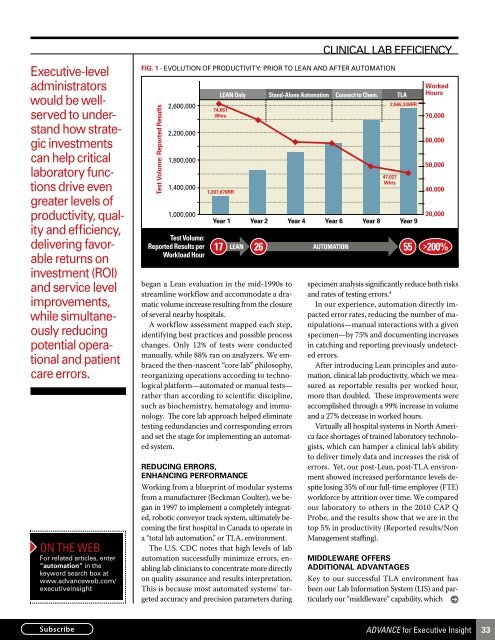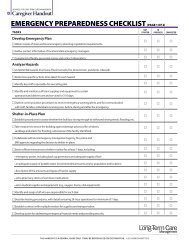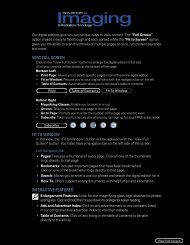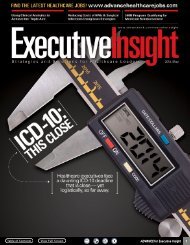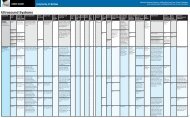1 ADVANCE for Executive Insight
1 ADVANCE for Executive Insight
1 ADVANCE for Executive Insight
- No tags were found...
You also want an ePaper? Increase the reach of your titles
YUMPU automatically turns print PDFs into web optimized ePapers that Google loves.
clinical lab efficiency<br />
<strong>Executive</strong>-level<br />
administrators<br />
would be wellserved<br />
to understand<br />
how strategic<br />
investments<br />
can help critical<br />
laboratory functions<br />
drive even<br />
greater levels of<br />
productivity, quality<br />
and efficiency,<br />
delivering favorable<br />
returns on<br />
investment (ROI)<br />
and service level<br />
improvements,<br />
while simultaneously<br />
reducing<br />
potential operational<br />
and patient<br />
care errors.<br />
FIG. 1 - EVOLUTION of productivity: PRIOR to lean and after automation<br />
Test Volume: Reported Results<br />
2,600,000<br />
2,200,000<br />
1,800,000<br />
1,400,000<br />
1,000,000<br />
Test Volume:<br />
Reported Results per<br />
Workload Hour<br />
began a Lean evaluation in the mid-1990s to<br />
streamline workflow and accommodate a dramatic<br />
volume increase resulting from the closure<br />
of several nearby hospitals.<br />
A workflow assessment mapped each step,<br />
identifying best practices and possible process<br />
changes. Only 12% of tests were conducted<br />
manually, while 88% ran on analyzers. We embraced<br />
the then-nascent “core lab” philosophy,<br />
reorganizing operations according to technological<br />
plat<strong>for</strong>m—automated or manual tests—<br />
rather than according to scientific discipline,<br />
such as biochemistry, hematology and immunology.<br />
The core lab approach helped eliminate<br />
testing redundancies and corresponding errors<br />
and set the stage <strong>for</strong> implementing an automated<br />
system.<br />
Reducing Errors,<br />
Enhancing Per<strong>for</strong>mance<br />
Working from a blueprint of modular systems<br />
from a manufacturer (Beckman Coulter), we began<br />
in 1997 to implement a completely integrated,<br />
robotic conveyor track system, ultimately becoming<br />
the first hospital in Canada to operate in<br />
a “total lab automation,” or TLA, environment.<br />
The U.S. CDC notes that high levels of lab<br />
automation successfully minimize errors, enabling<br />
lab clinicians to concentrate more directly<br />
on quality assurance and results interpretation.<br />
This is because most automated systems’ targeted<br />
accuracy and precision parameters during<br />
LEAN Only Stand-Alone Automation Connect to Chem. TLA<br />
74,661<br />
Whrs<br />
1,287,878RR<br />
47,027<br />
Whrs<br />
2,565,338RR<br />
Year 1 Year 2 Year 4 Year 6 Year 8 Year 9<br />
Worked<br />
Hours<br />
70,000<br />
60,000<br />
50,000<br />
40,000<br />
30,000<br />
17 LEAN 26 automation<br />
55 >200%<br />
specimen analysis significantly reduce both risks<br />
and rates of testing errors. 4<br />
In our experience, automation directly impacted<br />
error rates, reducing the number of manipulations—manual<br />
interactions with a given<br />
specimen—by 75% and documenting increases<br />
in catching and reporting previously undetected<br />
errors.<br />
After introducing Lean principles and automation,<br />
clinical lab productivity, which we measured<br />
as reportable results per worked hour,<br />
more than doubled. These improvements were<br />
accomplished through a 99% increase in volume<br />
and a 27% decrease in worked hours.<br />
Virtually all hospital systems in North America<br />
face shortages of trained laboratory technologists,<br />
which can hamper a clinical lab’s ability<br />
to deliver timely data and increases the risk of<br />
errors. Yet, our post-Lean, post-TLA environment<br />
showed increased per<strong>for</strong>mance levels despite<br />
losing 35% of our full-time employee (FTE)<br />
work<strong>for</strong>ce by attrition over time. We compared<br />
our laboratory to others in the 2010 CAP Q<br />
Probe, and the results show that we are in the<br />
top 5% in productivity (Reported results/Non<br />
Management staffing).<br />
Middleware Offers<br />
Additional Advantages<br />
Key to our successful TLA environment has<br />
been our Lab In<strong>for</strong>mation System (LIS) and particularly<br />
our “middleware” capability, which<br />
<strong>ADVANCE</strong> <strong>for</strong> <strong>Executive</strong> <strong>Insight</strong><br />
33


